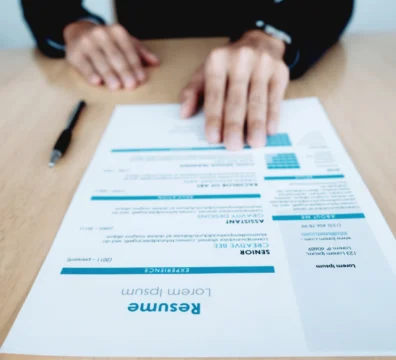Interviews can be intimidating not just for interviewees but also for recruiters. An interview provides an opportunity not just to assess a candidate but also for the candidate to evaluate the company. Thus, both parties need to put forward their best foot.
Interviews can be of multiple types depending on which part of the hiring pipeline is being taken and the role for which the hiring is taking place.
Interviews can be structured, unstructured, situational, behavioural, technical, etc. These interviews can also be conducted face-to-face, over the telephone, or in a video conference. This article talks about how to conduct structured interviews and why it is the most popular interview type.
What is a Structured Interview?
Research says only 20% of the applicants get selected for an interview, and only 30.89% of them receive an offer. Therefore, you need a structured interview in place to choose the right talent from such a tough competition.
It is the standard interview approach where the interviewer asks the same predetermined questions to all the selected applicants in the same order. Furthermore, they use a standardised scoring system to rate and rank these interviewees.
Recruiters feel this approach is more effective than other interview types and reduces the chance of bad hires. However, structured interviews don’t predict future job performance as cognitive tests or work samples can do.
But, it reduces discrimination issues as all applicants are treated fairly, and each gets the same opportunities to showcase their ability.
It is relevant in the recruitment of numerous fields, including human resources, political science, marketing, psychology, and more.
Types of Structured Interview
Recruiters can conduct a structured job interview face-to-face, over a telephone discussion, or a video conference.
Usually, a face-to-face interview gives the recruiter detailed information about the candidates, along with their facial expressions, body language, tone, etc. This ensures you are choosing a highly qualified professional and a culturally fit candidate. However, it is time-consuming, resource-intensive, and is vulnerable to biases.
According to a survey, 61% of recruiters believe video interviews will be the new norm. It eliminates the hassle of commuting, avoids biases, and is less resource-intensive.
Similarly, conducting a structured interview over an audio call is beneficial for the recruiter and the candidates. However, you can find difficulty in engaging with the interviewee over a telephone interview but not for video conferences.
How to Conduct a Structured Interview?
Like any other interview format, when you are about to conduct a structured interview, you must have a plan beforehand. For example, what questions to ask, how to grade the candidates, etc.
Therefore, we have listed below a few steps to help you get started with a structured interview in HRM.
Analyse Your Job Role
Before you set a structured interview, understand the tasks and responsibilities required for your openings. Additionally, you must also identify the skills, qualifications, and experience required for applying for the post. You must also determine which competencies can be measured through the interview.
For example, if you are hiring a project manager, a structured interview can help assess their communication, leadership, and problem-solving abilities. However, you need a skill assessment test to access their technical proficiencies like resource management and allocation.
Develop Lead and Probing Interview Questions
Now that you understand the requirements for the role, you must develop interview questions carefully. For example, if you want to evaluate six core attributes of a candidate, you can create a set of 12 structured questions. You can also get assistance from your legal department to review your question list to ensure compliance with local, state, and industry-related labour laws.
Determine Your Grading Scale
You must develop a standardised rating system for each question when organising structured interviews. Most employers use a scale of 1-5 or 1-10, with 1 being the low-quality response and 5 or 10 for the high-quality responses.
It ensures all the interviews are assessed on the same rating scale, and you don’t entertain biases.
Train the Interviewers on the Assessment Process
One of the most critical steps in conducting a structured situational interview is to train your interviewees on how to assess candidates. This includes
- setting an interview protocol
- asking pre-planned questions
- using a rating scale and scoring guide
- avoiding biases
Additionally, ensure the interviewer has relevant expertise and experience in determining candidates’ competencies and fit for the role.
Conduct Interviews
Now that you are ready to conduct a structured interview, schedule them with the selected applicants in advance. Additionally, ensure you communicate the interview details and expectations with the candidate via email or telephone.
During the interview, make sure you ask every candidate the same set of questions in the same order and listen to their responses actively and attentively. You can also take notes or record their answers and use a rating scale to score their replies.
Analyse Results and Make Decisions
After conducting the interview and collecting the data required, you must analyse their responses. The recruiter must focus on evidence and criteria rather than being biased toward the candidates:
- You must compare the scores and ratings offered to each candidate for their competency.
- Consider any other relevant information or feedback you recorded throughout the interview.
- You should check for inconsistencies, discrepancies, or data errors in the scoring and resolve them immediately.
- You must select the best candidate for the role depending on their potential, qualifications, performance, and cultural fit.
How Can 6 Pence Help with Hiring and Recruitment?
Structured interviews can offer numerous benefits to recruiters, from making effective hiring decisions to eliminating biases and streamlining the decision process. It allows you to hire the best-fit candidates irrespective of their backgrounds and focus on the DEI (Diversity, Equity, and Inclusion) initiatives.
However, if you aren’t getting the right-fit candidates in GCC, you can contact 6 Pence. We are the leading permanent and temporary staffing agency helping numerous businesses in Oman, Iraq, Bahrain, and Dubai. We provide end-to-end staffing solutions for our clients. Connect with us today to learn more!
Also Read: The Ultimate Guide to the Best Recruitment Tools for HR
Frequently Asked Questions
What is an example of a structured interview?
All questions asked in a structured interview are pre-planned, follow an order, and rank applicants with a standard rating system. For example, suppose you are conducting interviews for 10 candidates. In that case, your first question for all of them remains, “Do you believe the Earth revolves around the Sun, yes or no?” followed by, “Is Earth the only habitable planet, yes or no?” etc. This is a structured interview where all questions are the same and follow the same order.
What is structured and unstructured interview?
A structured interview refers to an approach where you have standard pre-planned questions for data collection that may be close-ended, open-ended, or a combination of both.
On the other hand, an unstructured interview is an approach when you don’t have any planned questions and involves a free-wheeling conversation with off-topic discussions and irrelevant feedback. However, you can equip facilitators with interview guides for asking relevant questions.
What are the advantages of structured interviews?
A structured interview is more time-efficient than other interview formats. It has a pre-planned set of questions, so it will likely go into tangents, especially if your questions are close-ended. If you provide more structure to the internet, you will generate better responses that are easy to analyse.




































































































